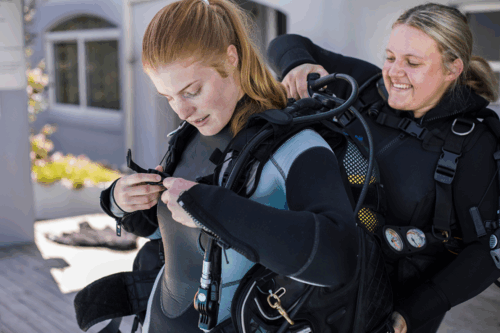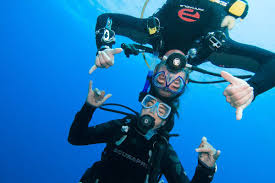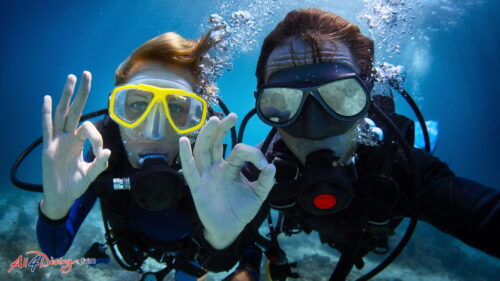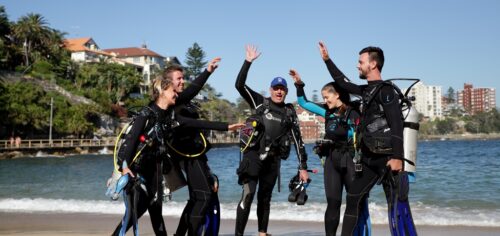Beyond Proximity: Elevating Your Buddy Partnership into a True Team
“Never dive alone” is the first rule we learn. But the buddy system is much more than simply having another person near you underwater. A truly effective buddy partnership is an active collaboration, a coordinated dance built on communication, awareness, and mutual trust.
In this final article of our Mastering Core Dive Skills series, we will dive deep into the “soft” but critically important skills that transform two individual divers into a real dive team. Drawing on our experience from thousands of guided dives and courses, Amadive will share the procedures and techniques that enhance safety, efficiency, and enjoyment on every single dive.
The Foundation: The Pre-Dive Strategic Huddle

A successful dive begins before you even get in the water. Taking 5 minutes to get on the same page eliminates the vast majority of underwater confusion and stress.
- Use Amadive’s S.A.F.E. Procedure:
- S (Signal Review): Don’t assume you both know the same hand signals. Quickly agree on the critical ones: “OK?”, “Problem,” “Ascend,” “Descend,” “Stop,” and most importantly, air signals (“Half tank,” “Turnaround pressure”).
- A (Air Management): “When are we turning back?” Agree on a specific number (e.g., “We start heading back when the first person reaches 100 bar”). This prevents a situation where one buddy wants to continue while the other is nearing their limit.
- F (Formation & Procedures): “Who is leading?”, “Will we keep the reef on our left or right?”, “What is our lost buddy procedure?” (Typically: search for 1 minute, then ascend safely to the surface).
- E (Emergency Plan): Briefly review emergency procedures like air sharing. “If you need air, you will take my alternate, located here.”
During the Dive: The “Awareness Triangle”

An excellent diver maintains a constant “awareness triangle.”
- Awareness of Self: What is my depth? How much air do I have? Am I feeling cold?
- Awareness of Buddy: Where is my buddy? Are they close? Do they look comfortable? What is their breathing rate like?
- Awareness of Environment: What is our heading? Where is the current coming from? Are there any creatures to be mindful of?
Amadive’s Experience Tip: The best habit is to create a check-loop every 30-60 seconds: Check my air -> Look at my buddy, give an OK signal -> Check my compass/environment -> Repeat.
Advanced Communication: Going Beyond “OK?”

- Proactive Communication: Don’t just respond to signals. Initiate them. Actively ask your buddy for their air pressure.
- Learn Unofficial Signals:
- Numbers: Learn to signal numbers to communicate exact air pressure (e.g., show 1 finger, then a 0, then a 0 = 100 bar).
- Marine Life: Agree on signals for creatures you hope to see (turtle, shark, nudibranch).
- Feelings: Signals like “I’m a little nervous” or “This is amazing!”.
- Use Other Communication Tools: A dive light can be used to get attention. An underwater slate is a great tool for more complex messages.
After the Dive: The Post-Dive Debrief

This is an often-skipped but incredibly valuable step.
- Action: Once on the boat with gear off, take a few minutes to talk with your buddy.
- Content: “That was a great dive! Did you see that moray eel?”, “Next time, maybe we should swim a bit slower to conserve more air.”, “I thought our boat entry was really smooth.”
- The Benefit: This reinforces what went well, provides learning opportunities for what could be improved, and most importantly, strengthens the partnership and friendship.
Conclusion: Being the Best Buddy You Can Be
Being an excellent buddy is not an innate talent; it’s a learned set of skills and attitudes. It begins with the recognition that your buddy’s safety and enjoyment are just as important as your own. By implementing these communication and awareness procedures, you not only ensure a safer dive, but you also make the experience infinitely richer and more connected.
